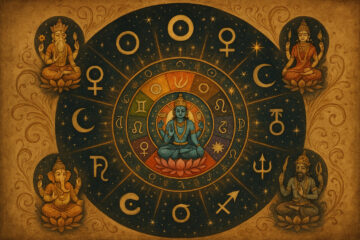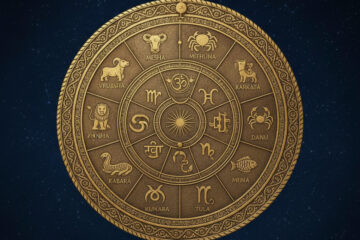You’ve already learned dignity, divisional charts, Lagna, Arudha, and Aṣṭakavarga. Now we move into the machinery of prediction — planetary aspects in Vedic astrology, sign exchanges, functional nature, karakatva, yoga kārakas, marakas. This is where charts stop being diagrams and start behaving like organisms. Planets don’t sit still. They look at each other, trade space, borrow authority. They make promises they are forced to keep later under daśā. Read this layer carefully. This is the language of consequence.
7. Aspects (Dṛṣṭi): How Planets See and Influence Each Other
Every planet aspects (casts a gaze on) the house directly opposite to it — the 7th house from itself. This is the default 180° aspect. If Mercury sits at 17° Virgo, it will aspect Pisces, especially the degrees close to 17°, but functionally across a workable orb (~12°–22° Pisces). The Sun’s influence is broader and more atmospheric — about ±10° of its exact aspect point.
An aspect is influence. Not physical placement, but pressure. Attention. A tether.
So if Mercury is at 17° Virgo and Jupiter sits around 12° Pisces, they are mutually aspecting. Two things instantly lock together:
- Functional relationship: the houses they rule (for example 3, 6, 9, 12) become intertwined in lived events.
- Generic relationship: Mercury’s intelligence, speech, negotiation links with Jupiter’s wisdom, ethics, faith. Education, counsel, mentorship, teaching — all get amplified.
This is how planetary aspects in Vedic astrology generate synergy even without conjunction. They create channels.
All planets aspect the 7th from themselves. But three grahas have special aspects — extended lines of force beyond the default 7th:
- Mars: aspects the 4th, 7th, and 8th houses from itself. This is aggressive, targeted, often confrontational.
- Jupiter: aspects the 5th, 7th, and 9th. This spreads protection, teaching, grace, expansion.
- Saturn: aspects the 3rd, 7th, and 10th. This applies pressure, discipline, and consequence across effort, relationship, and karma in the world.
Rāhu and Ketu are also read as casting powerful influence on the 5th and 9th from their positions (many practitioners use this rule in actual predictive work). These nodal aspects often indicate obsession, crisis, or accelerated karmic assignment in those houses.
Memorize these. They are not trivia. Aspects define where the planet is working even when it’s not physically there.
8. Exchanges (Parivartana Yoga): When Planets Trade Territory
Parivartana Yoga is sign exchange. Two planets occupy each other’s signs. Example: Mercury in Pisces, Jupiter in Virgo. They are now in each other’s houses, and they begin to behave like partners.
What this means in practice:
- Each planet gains access to the dignity and resources of the other’s sign.
- The houses ruled by those planets fuse. They start acting like one story.
- Both planets behave as if they are sitting in their own sign, even if technically they’re not.
This can create extremely powerful yogas, including wealth, authority, creative output, status, or relationship security — depending on which houses are involved. Exchanges between Kendra (1, 4, 7, 10) and Trikona (1, 5, 9) lords are especially potent. This is one way real “Rāja Yoga” patterns are born.
There are subtler forms too: nakshatra exchange (sūkṣma parivartana), where planets trade nakshatras. These subtler exchanges often reveal themselves during daśā/antardaśā timing. Even a planet that looks weak on paper can lift if it borrows strength through exchange.
This is not hypothetical. This is how charts cheat linear logic.
9. Karakatva (Planetary Signification): What a Planet Naturally Represents
Karakatva is what a planet “stands for” by nature — its built-in portfolio. Jupiter signifies wisdom, dharma, teachers, counsel, faith. Venus signifies love, pleasure, beauty, binding, agreements. Saturn signifies work, time, consequence, survival, endurance. Mars signifies assertion, control, blood, force, will.
When a planet sits in a house that already matches its karakatva, its ability to deliver becomes louder. For example: Jupiter in the 9th house. The 9th is fortune, higher learning, spiritual protection, teachers, blessing, father/guru principle. Jupiter already carries these significations. So Jupiter in the 9th tends to amplify dharma, guidance, philosophical clarity — if Jupiter is dignified and not shattered by malefic influence.
Another layer: functional ownership. For a Capricorn ascendant, Jupiter rules the 3rd and 12th houses. If Jupiter sits in the 9th, then courage/effort (3rd), loss/isolation/spiritual release (12th), and destiny/fortune (9th) entangle. Pilgrimage, foreign retreat, deep study, mentorship — these themes merge. You are watching the story structure of a life being written by planetary placement.
This is where planetary aspects in Vedic astrology and karakatva intersect. An aspect from Jupiter onto a house can “bless” that area with Jupiter’s karakatva. An aspect from Saturn can force maturation through pressure. Karakatva tells you what kind of energy is being delivered. Aspect tells you where it lands.
10. Positive and Negative Houses: Where Energy Flows Cleanly — and Where It Costs You
To read functional nature, you need to know which houses tend to behave cleanly and which behave like friction points.
- Trines (1, 5, 9): Auspicious. Dharma, creativity, identity, luck, protection.
- Kendras (1, 4, 7, 10): Pillars. These stabilize and manifest the life. Planets here gain visibility and weight.
- 11th House: Gains, achievement, desire-fulfillment, networks. Generally favorable for material progress.
- Dusthanas (6, 8, 12): Trouble houses. Conflict, disease, debt, loss, fear, surrender, endings, transformation. Necessary, but heavy.
- 3rd House: Effort, initiative, self-made grind. Often slightly harsh. You earn it yourself or you don’t get it.
Now map this to functionality:
Functional malefics (FM): Planets that rule houses like the 3rd, 6th, or 11th often behave as functional malefics because those houses relate to struggle, rivalry, debt, survival and ambition. They can bring drive and achievement, but the path is abrasive.
Neutral lords: Lords of the 2nd and 12th are often treated as neutral. Whether they help or harm depends on what else they rule and how they’re placed.
Benefics ruling Kendras: When natural benefics (Jupiter, Venus, Moon, Mercury when clean) rule only Kendras, they sometimes lose their pure benefic force unless they also own a Trine. They stabilize life — but may not actively uplift it.
Malefics ruling Kendras: When natural malefics (Saturn, Mars, Sun, Rāhu, Ketu) rule Kendras, they can become constructive. They gain responsibility and start building instead of only breaking. This is one path to power.
Yoga Kāraka: A planet that rules both a Kendra (1, 4, 7, 10) and a Trine (1, 5, 9). Yoga kārakas are elite. They are allowed to deliver material success, visibility and meaningful growth. They’re often life-defining during their daśās.
Marakas: Lords of the 2nd and 7th houses are called marakas (“killers”), because under very specific timing they can challenge health, vitality, or lifespan. But don’t panic-read this. Those same lords can also bring wealth, status, comfort, influence. If a maraka planet also rules a Trine, its destructive potential weakens dramatically. In daily life, maraka daśās often feel like “body under pressure, needs medical attention,” not instant fatality.
Important subtleties:
- Benefics get weaker if combust or buried in duṣṭhānas with no support.
- Moon and Mercury are adaptive: benefic with benefics, malefic with malefics. They absorb company.
- A planet’s mūlatrikoṇa sign (its core operational sign) usually gets interpretive priority over its other sign.
- When Sun or Moon rule the 8th or 12th, they lean neutral. They don’t always behave purely as benefics in those charts.
This is why functional nature outranks generic nature. Jupiter is not “good” for everyone. Saturn is not “bad” for everyone. You judge what they rule for that specific Ascendant, and how they’re placed.
11. Functional Nature and Planet Alliances
At this layer you’re reading not just planets alone, but alliances. Which planets work together, and which interfere. Traditional Jyotiṣa often observes two broad clusters:
- Saturn – Venus – Mercury – Rāhu often act in one coalition, trading themes of material design, strategy, technical skill, finance, attraction, social structure, logic, hunger, ambition.
- Sun – Moon – Mars – Jupiter – Ketu often act in another coalition, trading themes of vitality, authority, clarity, righteousness, courage, spiritual intensity, severance, purification.
This is not a rigid law, but a working intuition. Over time, when you read planetary aspects in Vedic astrology, you’ll watch these coalitions form, clash, or merge in a single chart. That’s when you start to see the plotline of a life — where the native pushes, where the native resists, where the native bleeds, and where the native ascends.
With practice, you’ll be able to look at a chart and instantly say: “This is a Saturn–Venus driven life” or “This life runs on Sun–Mars fuel.” That’s functional nature in action. That’s the skeleton key.
Important Notes
Do planetary degrees matter for strength?
Yes. Degree proximity is power. A yoga is strongest when planets are within ~8–10 degrees of each other; beyond ~15° the effect weakens. Always check dispositors — who rules the signs those planets sit in — in Rāśi, Nakshatra, and Navāmśa. Sometimes the dispositor quietly decides whether the yoga actually manifests.
Do planets in Kendras automatically “see” all other Kendras?
In Parāśara astrology, aspect strength is directional: 100% to the 7th, 75% to the 4th, 25% to the 10th, except Saturn gives full 100% to the 10th. Jaimini uses sign-to-sign aspects: movable to fixed (with exceptions), fixed to movable, dual to all dual. Practically: planets placed in Kendras from each other tend to influence each other strongly, even without an exact textbook aspect. The relationship is alive because the houses are angular and loaded.
Can a debilitated planet in exchange still help?
Yes. A debilitated planet in Parivartana Yoga can still produce meaningful results if the exchange links strong houses (like Kendras or Trikonas), or if benefic aspects support it, or if Navāmśa (D9) repairs the dignity. Debilitation is not instant failure. Exchanges are a rerouting of authority.
How do functional benefics behave in duṣṭhānas like the 6th or 8th?
With cost. A functional benefic in the 6th might give victory through struggle — litigation wins, enemies defeated, disciplined service — but also health stress or constant conflict. In the 8th, even benefics can become heavy, secretive, crisis-bound. The 12th can dissolve comfort into sacrifice. Nuance always depends on sign dignity, aspects, and Aṣṭakavarga support.
Do sign exchanges in divisional charts (like Navāmśa or Daśāṁśa) matter?
Yes. Exchanges in D9 (marriage/dharma) or D10 (career/status) can activate during relevant daśās and reshape outcomes in that domain. A Parivartana in D10 can signal career partnership, strategic alliances, or sudden elevation during a professional daśā — even if D1 alone didn’t scream “success.”
Why can Sun in the 8th house create reproductive stress?
The 8th house governs deep vulnerability, sexuality, reproductive organs, and crisis. The Sun is hot, dry, consuming. In some charts, an afflicted Sun in the 8th can overheat that zone, symbolically drying lunar fertility. This can correlate with miscarriage risk or stress in gestation, unless supported by a strong Moon or Jupiter. Always confirm with divisional charts focused on children (like Saptāmśa / D7).
Which matters more: the planet sitting in a house, or the house lord?
Both — but the occupant often screams louder. The planet physically sitting in a house behaves like an event. The house lord behaves like context, ownership, theme. A weak house lord can undermine outcomes even if the occupant looks strong, and vice versa. You read them together.
How do Maraka planets act in their daśā?
Marakas (2nd and 7th lords) are capable of delivering bodily fatigue, health interventions, medical crises — especially late in life if indicated. But maraka daśā is not automatically “death window.” Often it’s a period of physical cost, surgery, recovery, consequence. If a maraka also rules a Trine, its destructive edge softens. You should never weaponize maraka talk casually.
Why is Venus considered “mixed” for Taurus Ascendant?
For Taurus Lagna, Venus is Lagna lord — beautiful, magnetic, central. But Venus’s mūlatrikoṇa sign is Libra, which lands in the 6th house (a duṣṭhāna). So Venus is both life-force and 6th-house lord. The result: charm, attractiveness, artistic refinement — but also entanglement with service, health stress, rivalry, obligation. It’s grace with a cost.
Why is Jupiter still considered malefic for Libra Ascendant, even exalted?
Because Jupiter rules the 3rd and 6th houses for Libra Lagna — effort, conflict, debt, enemies, service. Those are duṣṭhāna / struggle houses. So even an exalted Jupiter can behave as a functional malefic. It may create reputation and moral authority, but it can also bring conflict, pressure, obligation. Functional nature outranks generic reputation.
FAQ — Aspects, Exchanges, Functionality
Why are planetary aspects so crucial in chart analysis?
Planetary aspects in Vedic astrology are how energy moves. An aspect is a line of force. It lets one planet modify another planet’s expression without sharing the same house. Tight aspects (within ~8°) act almost like conjunctions. They stitch houses and stories together. This is essential for prediction.
What happens when many exchanges and aspects happen at once?
The chart becomes heavily networked. Don’t drown in it. Track the tightest interactions first: close aspects, strong Parivartana Yoga, and alliances between Kendra and Trine lords. Then match those to daśā timing. The rest is noise until activated.
Can a debilitated planet in Parivartana still create Rāja Yoga?
Yes. If the exchange ties together Kendra and Trine houses — or involves a yoga kāraka planet — you can still get authority, status, breakthrough. Debilitation colors the experience (you win but bleed for it), but it doesn’t block the rise outright.
How do Parāśara aspects differ from Jaimini aspects?
Parāśara aspects are planet-based and degree-sensitive. Jaimini aspects are sign-based and pattern-driven: movable signs aspect fixed (except adjacent), fixed aspect movable, dual aspect all dual. Parāśara shows force flow. Jaimini shows structural resonance. You can use both.
Why does Saturn in the 3rd house often indicate self-made effort?
The 3rd house is grind, initiative, courage. Saturn is endurance, discipline, delayed gratification. Saturn in the 3rd says: “Nobody will save you. Build yourself.” These natives often earn what they have, slowly, with proof. They don’t inherit ease — they construct it.
Does a waning Moon automatically become malefic?
No. A waning Moon can reduce emotional steadiness or nourishment. It can create sensitivity or volatility. But “malefic” is too simple. You must judge: house rulership for that Lagna, dignity, aspects, Aṣṭakavarga support. A waning Moon supported by Jupiter can still be profoundly protective.
How do I use transit aspects in prediction?
Transits matter when they strike natal pressure points. For example, a Saturn–Ketu transit might create austerity, detachment, surgical changes — but the actual effect depends on where that transit lands relative to your natal houses and planets. Natal always comes first. Transit is activation, not source code.
Why do benefic planets sometimes act negatively when ruling Kendras?
Because Kendras stabilize karma. A benefic ruling only Kendras can get “neutralized” — it maintains structure but doesn’t always lift you. Unless that same planet also rules a Trine, it may not behave as a classic giver of grace. This principle is central to identifying a true yoga kāraka.
Why is functional nature more important than generic nature?
Because generic nature is mythology. Functional nature is your chart. Jupiter is “the great benefic” in theory, but if it rules the 3rd and 6th for your Lagna, it drags you into rivalry, obligation, burnout, and service. Saturn is “the difficult one,” but if Saturn is yoga kāraka for your Lagna, Saturn becomes the builder of your empire. Always read the planet inside the context of the Ascendant.
Conclusion — Reading Planets as Forces, Not Labels
Planetary aspects in Vedic astrology weave planets together. Parivartana trades ownership. Karakatva tells you what a planet is capable of giving. Functional nature tells you who it’s really working for. Yoga kārakas protect. Marakas test. None of this is moral. It’s mechanical. It’s karmic engineering.
When you see how these forces cooperate or collide, you stop asking “Is this good or bad?” and you start asking “What is this planet trying to build in me, and what will it take from me to build it?” That’s when real interpretation begins.
Ask your karma. Decode your chart at Much Needed Astro.



